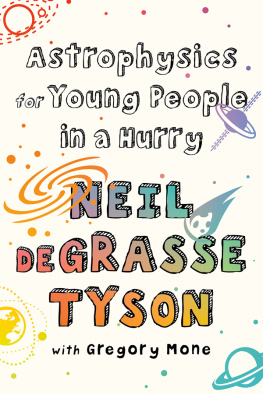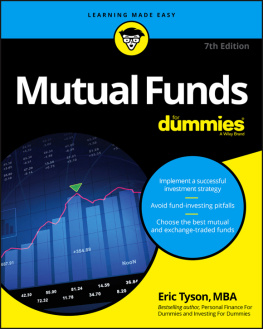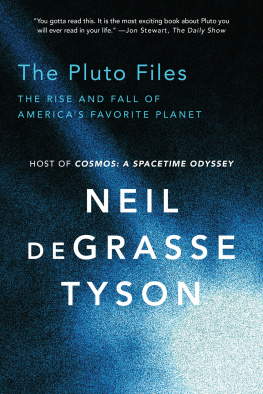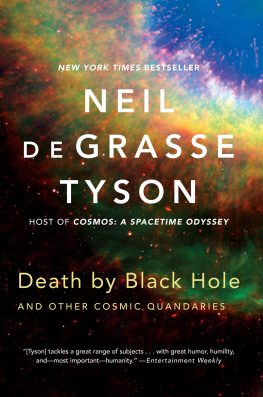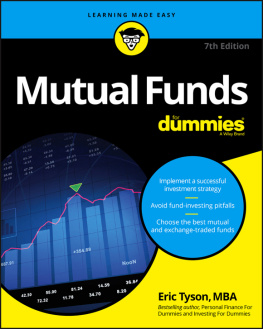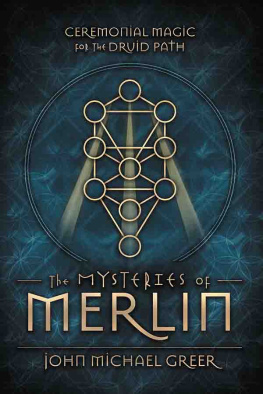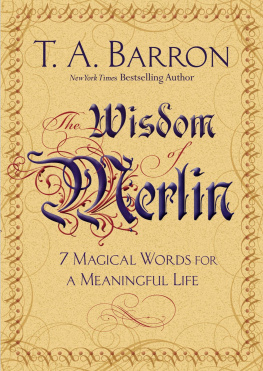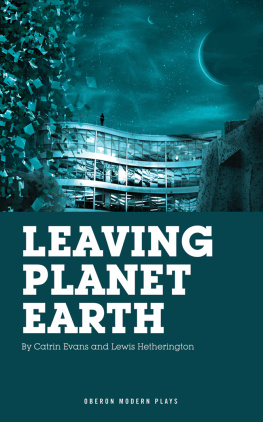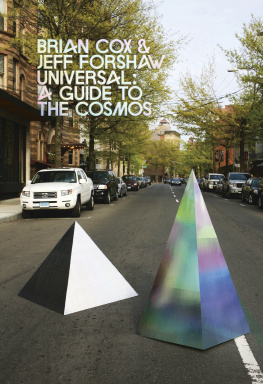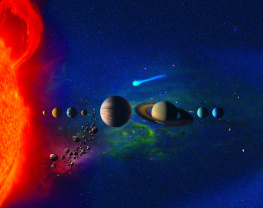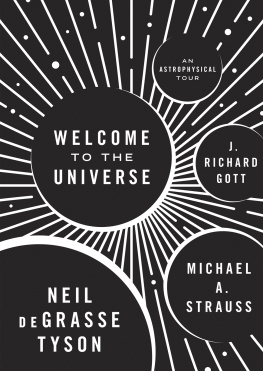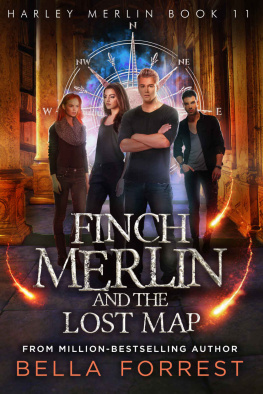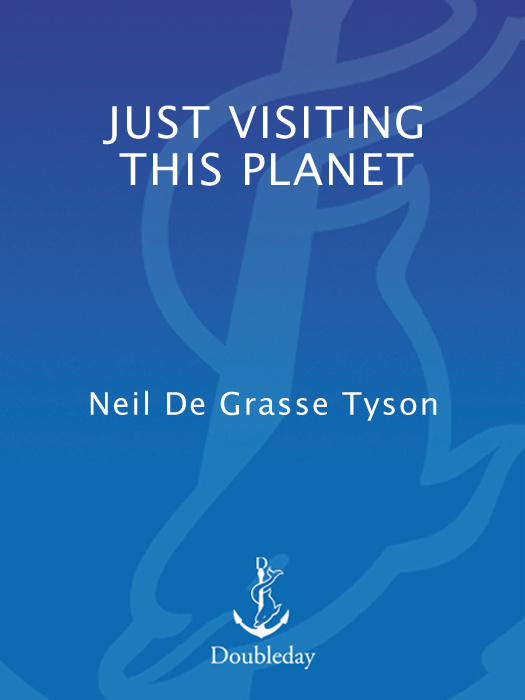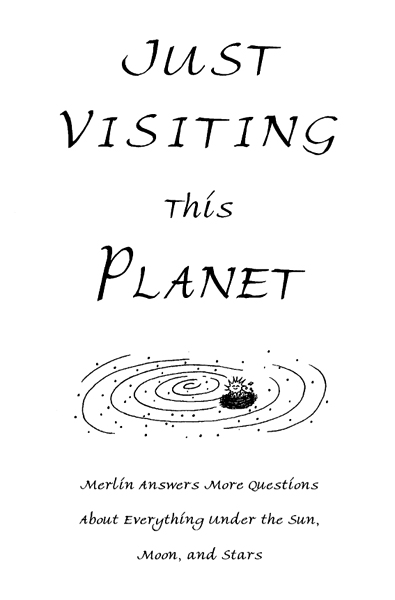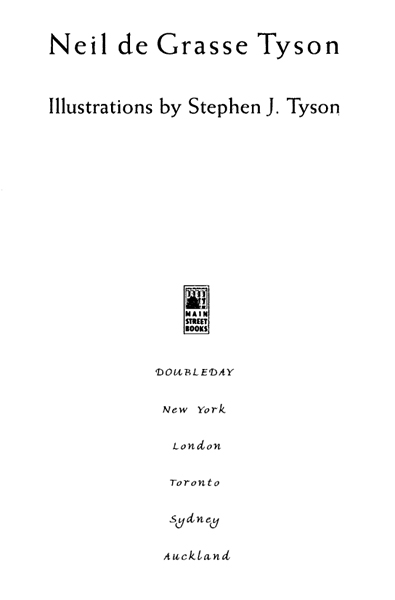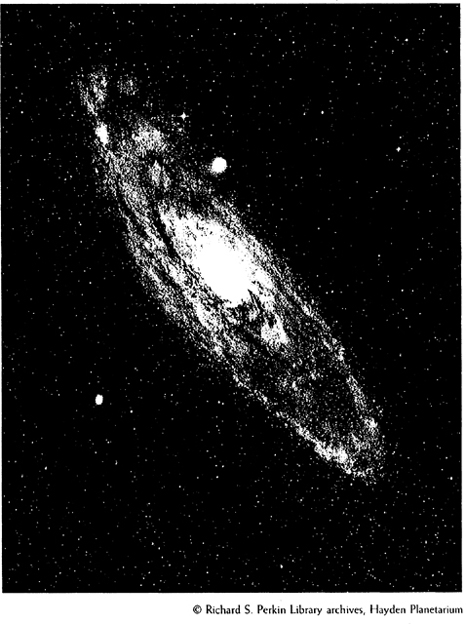
The Andromeda spiral galaxy, Merlins homea gravitationally bound collection of more than 300 billion stars located 2.2 million light-years from the Milky Way.
Also by Neil de Grasse Tyson
U NIVERSE D OWN TO E ARTH
M ERLINS T OUR OF THE U NIVERSE
A M AIN S TREET B OOK
PUBLISHED BY DOUBLEDAY
a division of Bantam Doubleday Dell Publishing Group, Inc.
1540 Broadway, New York, New York 10036
D OUBLEDAY , M AIN S TREET B OOKS , and the portrayal of a building with a tree
are trademarks of Doubleday, a division of Bantam
Doubleday Dell Publishing Group, Inc.
Library of Congress Cataloging-in-Publication Data
Tyson, Neil de Grasse.
Just visiting this planet / Neil de Grasse Tyson.
p. cm.
1. AstronomyMiscellanea. 2. AstrophysicsMiscellanea.
I. Title. QB52.T94 1998
520dc21 97-47122
eISBN: 978-0-307-78409-4
Text copyright 1998 by Neil de Grasse Tyson
Illustrations copyright 1998 by Stephen J. Tyson
All Rights Reserved
August 1998
v3.1
T o all those
who have always looked up,
and to all those
who do not yet know
why they should
A CKNOWLEDGMENTS
I began writing the Merlin column for Star Date magazine (then known as the McDonald Observatory News) in 1983, and have written it ever since. While the character development of Merlin and the full content of both books derived from the column are original to me, the Q&A column itself was created several years before by David Slavsky, then a graduate student at the University of Texas at Austin and now dean of students at Loyola University in Chicago. Between Slavsky and me, there were short terms of authorship by Jeff Brown and Suzanne Hawley.
During the first few years that I wrote the column, Damond Benningfield, then editor of Star Date (and now its executive editor), offered several stylistic insights that have remained with the column. One of them is the fact that Merlin speaks only in the third person, which lends the column its all-knowing Miss Manners style.
Over my years of writing the column I have benefited from comments and corrections through consultation with many colleagues, but especially from Drs. Jeff Brown, the late Harlan Smith, Tom Barnes, Rick Binzel, Mike Rich, and Robert Lupton. As always, my sister, Lynn Tyson, has served as a sounding board and as an anchor to reality for many of my literary experiments before they are penned.
C ONTENTS
I. Your Home Zone
Earth and its cosmic environment
II. Planets, Their Moons, and Other Cosmic Debris
The rest of the solar system
III. Stars, Near and Far
The Sun and its stellar siblings
IV. Galaxies, Near and Far
Milky Ways and Silver Rivers
V. A Look at the Day Sky
For those who sleep at night
VI. A Look at the Night Sky
For those who sleep in the day
VII. The World of Light
A key to cosmic knowledge
VIII. The World of Physical Laws
Some of the ways in which the universe works
IX. Time and Space
Youve never experienced one without the other
X. Our Universe
Up close and personal
XI. One Step Beyond
Reaching and exceeding the bounds of imagination
XII. The World of Merlin
Getting intimate with the Omniscian
Appendix
P REFACE
J ust Visiting This Planet is the second collection of real questions about the universe asked by real people and answered by the fictional character Merlin, who is a scholar visiting Earth from the planet Omniscia in the Andromeda galaxy.
Nearly all questions and answers contained in Just Visiting This Planet first appeared in the popular-level Q&A column Merlin of Star Date magazine, published by the McDonald Observatory of the University of Texas at Austin. The questions generally come from a broad mix of working and retired adults, with occasional entries from schoolchildren and even prison inmates.
As a literary vehicle, I have rebuilt the famed Merlin character of Arthurian legend into an educational tool that allows me to explore creative ways of bringing complex topics of the universe within reach of the lay reader.
The units of measure used herein were selected on the basis of whatever was natural for the content and style of the question-answer pair. To decree that all units be on the same system (either scientific, engineering, international, or American) would needlessly muddle much of the content. For example, you wouldnt ask for 1.38-inch film for your camera when its labeled 35mm. And we all know to ask for a half-gallon of milk at the supermarket, but the same supermarket also sells cola in two-liter bottles. In the end, I valued frictionless communication over intemperate rules.
The Merlin character simultaneously embodies my enthusiasm for astrophysics and my daily desire to share cosmic discovery with the public. Your enjoyment will be my reward.
N EIL DE G RASSE T YSON
N EW Y ORK C ITY
J ANUARY 1998
I NTRODUCTION
M erlin is as old as Earth and has been an eyewitness to nearly all major human discoveries in the physical sciences. On temporary leave from homethe planet Omniscia in the Draziw star system of the Andromeda galaxyMerlin has chosen Earth and its scientific legacy as a topic of academic research. Merlin has advanced degrees in astrophysics, geophysics, chemistry, and philosophy, all earned at Omniscias planetwide Universe-ity.
A consummate scholar-educator, Merlin loves nothing more than to answer your questions about our favorite universe. Steadfastly succinct yet always friendly, Merlins replies are occasionally enriched by recollections from the pasta past that contains a motley assortment of Merlins Earth-based friends and acquaintances, including Archimedes, Galileo, Einstein, and Santa.
I
Y OUR
H OME Z ONE
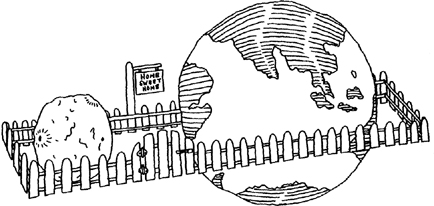
Dear Merlin,
Does the Coriolis effect cause water to swirl down drains in different directions in different hemispheres? What about on the equator?
B ILL D ELLINGES
N EWARK, C ALIFORNIA
I t depends on the size of your kitchen. If your kitchen sink is a few hundred miles in diameter, then the Coriolis forces induced by the rotating Earth will easily overcome the random water currents and drive the sink to empty its contents in a counterclockwise swirl. If you have Southern Hemisphere friends with an equally large kitchen sink, then theirs will indeed empty in the opposite (clockwise) direction.



